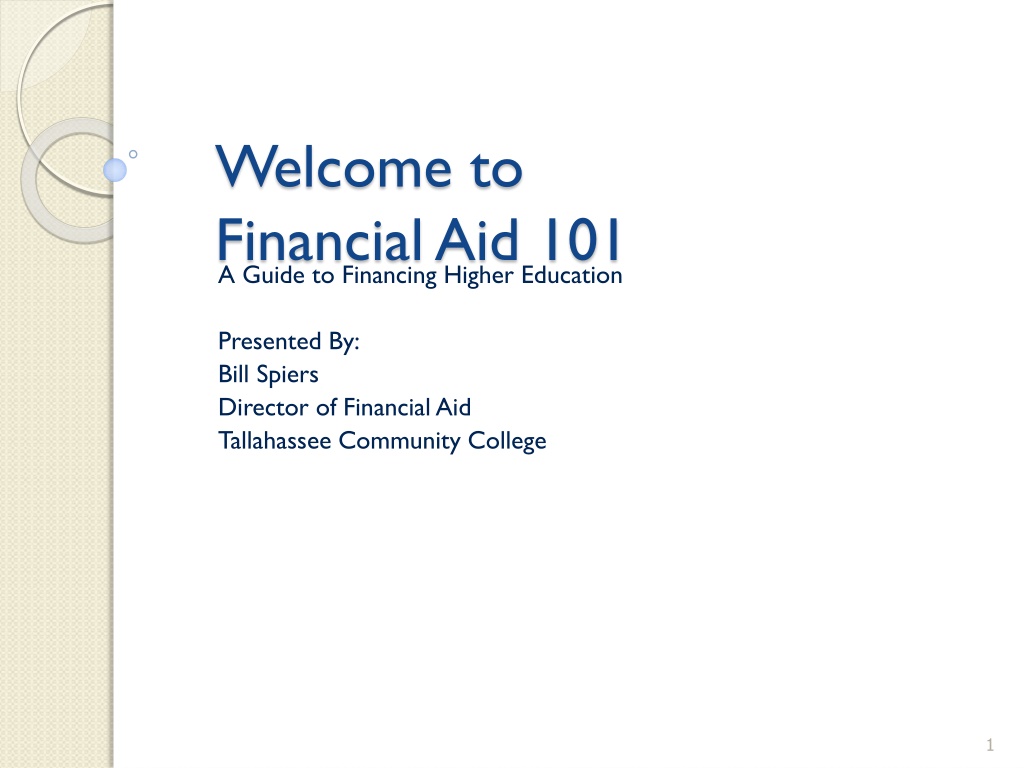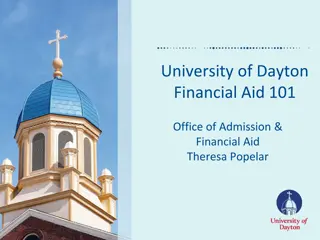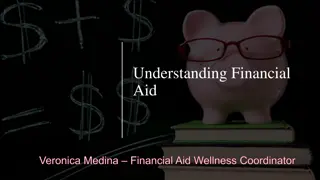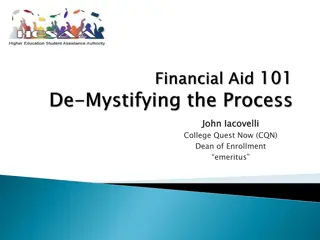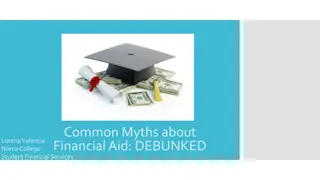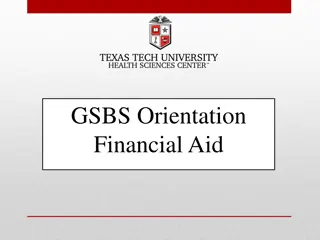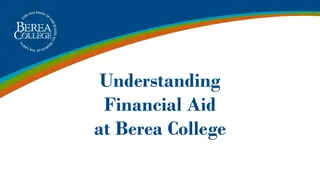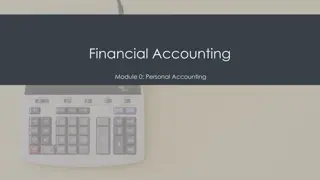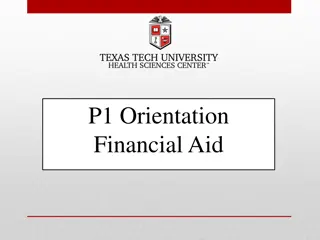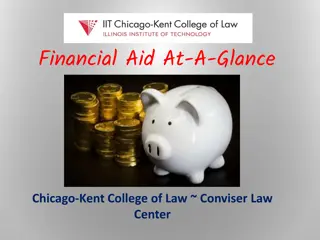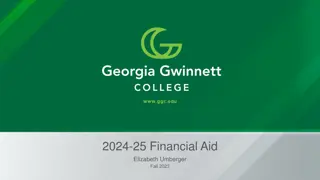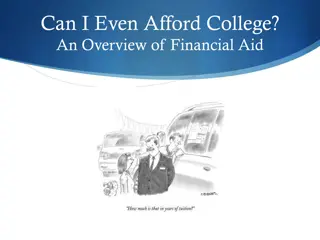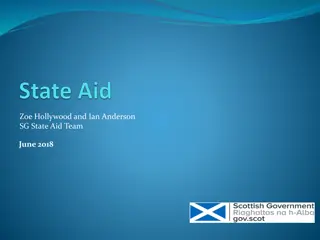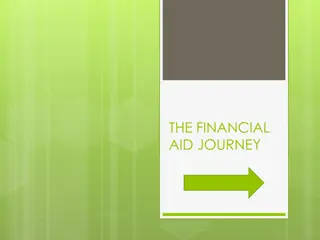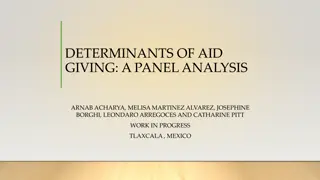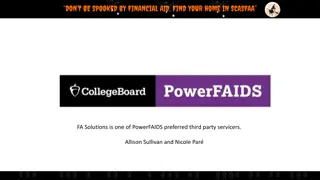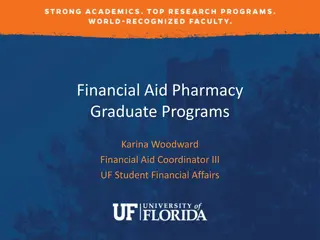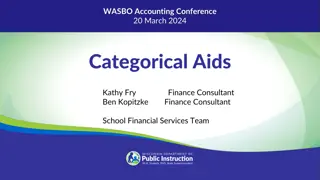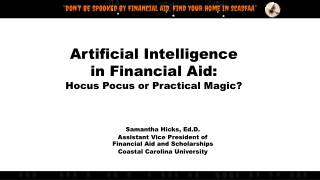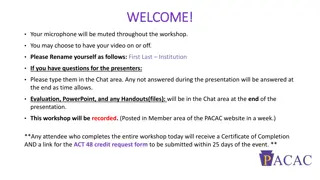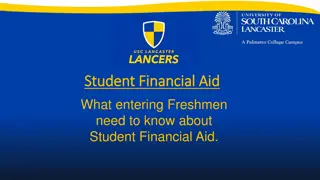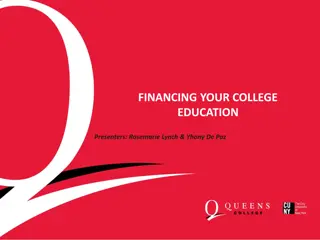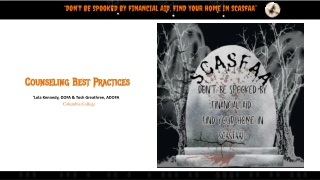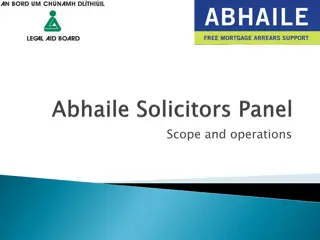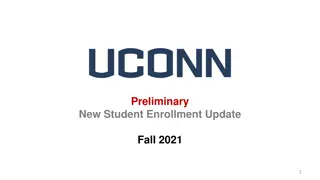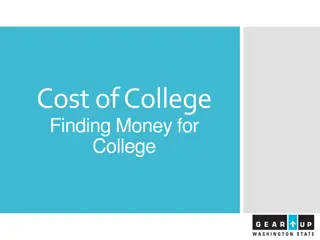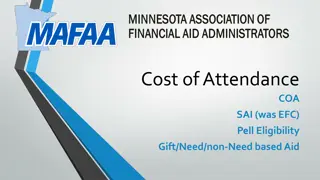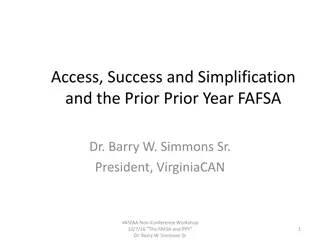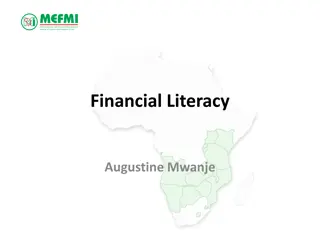Understanding Financial Aid for Higher Education
Exploring the world of financial aid, this guide covers who bears the responsibility of funding higher education, how families can receive help with educational costs, and the factors that determine family contribution. It delves into the distinction between dependent and independent student contributions and explains how financial need is calculated based on the cost of education and expected family contribution.
Download Presentation

Please find below an Image/Link to download the presentation.
The content on the website is provided AS IS for your information and personal use only. It may not be sold, licensed, or shared on other websites without obtaining consent from the author. Download presentation by click this link. If you encounter any issues during the download, it is possible that the publisher has removed the file from their server.
E N D
Presentation Transcript
Welcome to Financial Aid 101 A Guide to Financing Higher Education Presented By: Bill Spiers Director of Financial Aid Tallahassee Community College 1
Who Pays for Higher Education? The primary responsibility for funding higher education rests with the student and, where appropriate, his/her family. 2
What If the Family Needs Help With the Cost of Education? When a family cannot afford to pay the full cost of education, as determined through a national system of needs-analysis, financial aid steps in to help. 3
How Much is a Family Expected to Contribute? Family Contribution is determined through a system called Federal Methodology. This system was developed by the US Congress and implemented by the US Department of Education. All schools use this system for determining a student s family contribution. 4
What Is Included in the Family Contribution for a Dependent Student s contribution from: 1. Income 2. Assets 3. Un-taxed income Parent s contribution from: 1. Income 2. Assets 3. Un-taxed income 4. Pre-paid and 529 Programs Inclusive of those owned by the Student 5
Dependent Contribution Cont. Number of family members. Number in college, excluding parents. Age of older parent. Other items can be considered under professional judgment by each individual school, including parents in college, K-12 private education, change in the family s financial circumstances. 6
Determining an Independent Student s Contribution The only difference in determining a dependent and an independent student s contribution is the elimination of the parent s contribution for the independent student. All of the other items are the same. 7
How Is Need Determined? Cost of Education Expected Family Contribution = Need 8
Cost of Education Includes: Tuition Fees Room Board Books Transportation Personal Expense 9
Important Facts About the Cost of Education Varies by school Covers some, but not all of a student s true personal expenses Does not determine affordability 10
Important Facts About the Expected Family Contribution Called EFC. Is a constant does not change based on cost of education. Usually is more than a family feels they can contribute. Is the best device we have to determine need. 11
Important Things To Remember As You Apply For Financial Aid Apply Apply early Follow up Communicate Watch out for the scams 12
Apply! For Scholarships Use Free Sources Only!!! Library Community Financial Aid Office Guidance Office Internet www.fastweb.com www.fastweb.com www.finaid.org www.nasfaa.org www.salliemae.com www.finaid.org www.nasfaa.org www.salliemae.com 13
Apply! Cont. Financial Aid Free Application for Federal Aid (FAFSA) at www.studentaid.gov Form opened for 2021- 2022 October 1! Federal Student Aid ID FED ID at www.studentaid.gov. Institutional application State of Florida Application College Board Profile (limited number of Schools. Can only be used for institutional funds.) www.studentaid.gov www.studentaid.gov 14
Apply Early! Find out deadline dates. Keep a list of deadlines you need to meet and check them off when they have been met. Meet deadlines!! 2021-2022 Application process startes October 1, 2020 using the 2019 tax information!! Remember, when you miss a deadline, you throw money away. 15
Follow Up! Make sure the documents you send are received. Keep a copy of EVERY document you send!!! Make sure additional items are not needed. Make sure your file is active. Note: Never send Social Security Number by email unless the email is password protected. 16
Communicate! Communicate changes in the family s circumstances. Familyincome. Family Size One Time Income Unusual Medical Expense Sibling Private K-12 tuition Divorce Death Parents in College Communicate any special needs or circumstances! 17
Watch Out For the Scams!!! Watch out for people who offer to help fill in your paper work for a fee! Watch out for people who want to charge you to look for scholarships! Watch out for people who want to sell you something so you can get financial aid! 18
Tips for Completing the FAFSA Gather tax documents. Remember we are using prior, prior year data Read the instructions Follow directions Check your work Complete a new form each year student is in school The 2021-2022 application opens October 1, 2020 using the 2019 tax information!!! 19
Tips for Completing the FAFSA Cont. Students are dependent until the age of 24. Divorced parents who are remarried are considered married. Step-parents financial information is included on the FAFSA. Non-custodial biological parents information is excluded from the FAFSA. Unmarried parents living in the same household should include both incomes. Dependent students who receive SSI should include their benefits under the parent s section. If at all possible, file your taxes prior to completing the FAFSA and use the IRS match. The FAFSA will be using tax information from 2019 for 2021-2022. All Taxes should have been filed. Estimate taxes as a last resort, but estimate if it means meeting a deadline. This option is going away in the near future. 20
Tips for Completing the FAFSA Cont. If you estimate your income, estimate accurately. Don t over estimate or underestimate. Use the IRS Data Retrieval Tool if at all possible!! Make sure you use the correct school code. Only the biological or adoptive parents should complete the form for dependent students. Students adopted at 13 years old or older are independent Remember to sign the form for the paper copy, or secure a FED ID from the US Department of Education if filing electronically, or print the signature page if you do not have a FED ID and file electronically. Students and parents must obtain their own FED ID! Parents only need one FED ID for multiple students If you need help, ask! 21
Sources of help Your chosen college or university. The US Department of Education on-line at www.fafsa.ed.gov Or with the US Department of Education by phone at 1-800-4-FED-AID (1-800- 433-3243) 22
Changes To Process Limited use of estimated income Form will be available for 2021-2022 October 1, 2020 If you use the DRT it will not import financial data where you can see it! Federal Pell Grant is year round. FAFSA now mobile! 24
When You Receive Your SAR You will receive a response by email. Check it for accuracy. Make sure all of the schools you are interested in are listed. Check with the schools you are interested in to see when they begin issuing award letters. See if you are selected for verification, as you will be required to send additional documents to your school. 25
When the School Has Your ISIR Record (Schools copy of the SAR) The school will check to see if you are selected for verification and request additional documents if you are. At the time selected by the school, and if your file is complete, the school will determine your need and issue an award letter, if you have need, indicating which funds you will receive. If you are selected for verification and errors are found, the school will have to make corrections, a process that will slow the delivery of your financial aid. Note: If selected for verification and if you did not use the IRS match, you will have to submit a tax transcript. You can submit your IRS 1040 form but it must be signed at some schools!! You may be able to print a IRS Income Tax Transcript on demand from the IRS site if the system is back up! 26
Award Letters Tells you how much aid you will receive. Tells you what kind of financial aid you will receive from one or more of the types of aid available. Tells you how to cancel your financial aid. Tells you how to modify your financial aid. Tells you how to reject part of your financial aid. 27
Type of Aid You Might Receive Scholarships Grants Need-based grants Work Loans 28
Need-based Grants Federal Pell Grants Federal Supplemental Opportunity Grants Florida Student Assistance Grants Institutional need-based grants 29
Scholarships and Grants Usually based on academics or talent. Usually have conditions attached such as a music or football scholarship or an academic scholarship with grade point average requirment. Are gift money and do not have to be repaid. 30
Where to find Scholarships Several places to find scholarships were listed earlier in the presentation. Please utilize the sources listed there. 31
Work Study Federal Student Work Study Florida Work Experience Program Campus Sponsored Jobs 32
Loans Ford Direct Loans (Subsidized and Un- subsidized) Parent s Loans (PLUS) Perkins Loans Private Loans Borrow wisely and never borrow more than you need. 33
Florida Prepaid College Plan Tuition Plan Local Fee Plan Tuition Differential Plan Dormitory Plan 34
Florida Prepaid College Plan Tuition Plan Covers basic class cost inclusive of matriculation, capital improvement, and financial aid fees. Three plans: 4-Year University Plan 120 undergraduate credit hours. 2+2 Tuition Plan 60 community college hours and 60 university undergraduate credits. 4-Year College Plan 120 hours at a State College 2-Year Community College Tuition Plan 60 community college credits. 35
Florida Prepaid College Plan Local Fee Plan Covers same items as the Tuition Plan. Covers the activity and service, health, and athletic fees. Supplements the Tuition Plan. 36
Tuition Differential Plan Covers tuition differential fee at a state university Supplement to the Tuition Plan All four year university or 2 year plans in existence prior to July 1, 2007 are exempt from the tuition differential fee. 37
Florida Prepaid College Tuition Dormitory Plan Covers cost of a standard, double-occupancy, air- conditioned dormitory room. Can be used toward University housing, and some fraternity and sorority houses and at select community colleges. Can only be purchased for time in a 4 year university. Cannot be purchased for students at a community college. 38
Florida Prepaid College Plans You must notify the school, usually the Business Office, of your participation. Information is usually confirmed electronically, though some institutions may use a manual process. An identification card will be mailed to students in the spring of their senior year with instructions on how to use their plan. For help contact: 1-800-552-GRAD (4723) www.myfloridaprepaid.com www.myfloridaprepaid.com 39
Florida Bright Futures Scholarship Changes Academic Scholars pays 100% of tuition and normal fees at a public college or university, plus a $300 book allowance during the fall and spring. Funds are available in summer. Medallion pays 75% of the normal fees at a public college or univeristy. Funds are available in the summer. Gold Seal Funds now pay 75% of normal fees at a public college or university. Students must repay Bright Futures if they withdraw from a class in an amount equal to the number of hours withdrawn multiplied by the State per credit hour rate for Bright Futures. Students must repay even if they withdraw from class on the last day of the term. 40
Florida Bright Futures Scholarship Changes Students with fully documented unusual and mitigating circumstances can appeal the requirement to repay. Renewal criteria requires students to complete the appropriate number of hours for their enrollment status Students who receive Gold Seal Scholarships cannot renew as a Medallion scholar. 41
Florida Bright Futures Scholarship Changes Summers cannot be used to make up grade point average or earned hours issues. May receive funding for up 5 years after high school graduation Community Service Hours FAS- 100 FMS- 75 GSV- 30 42
Florida Bright Futures Scholarship Changes SAT/ACT Scores Academic Scholars 1290/29 SAT/ACT Scores Medallion Scholars 1170/26 43
Preparing for the Scholarship Interview or Essay Know about the scholarship. Know about the organization offering the scholarship. Answer every question on the application. Never use a prepared essay. 44
Preparing for the Scholarship Interview or Essay Practice for the interview. Answer all questions honestly and with your opinion. Always be able to justify your opinion. Know your strengths and weaknesses. Know your likes and dislikes. Know current events. Dress conservatively. 45
Remember! If you think education is expensive, try ignorance. Derek Bok The average college graduate will earn 1.5 million dollars more in a life time. Is education a good investment? You bet it is! 46
Thank You for Coming! You ve been a great audience!! Bill Spiers, TCC Phone Number 850-201-6133 E-mail spiersb@tcc.fl.edu 47
